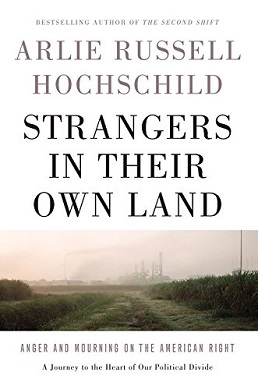In Louisiana, the pollution from the industrial plants that line the Mississippi River between Baton Rouge and New Orleans has created “Cancer Alley.” Yet in election after election, Louisiana voters elect politicians who promise to protect the oil and chemical companies. As these companies ravage Louisiana’s environment, politicians decry the EPA and the Federal government. They espouse their love of the free market and small government while relying on the Federal government to supply over 40% of the state’s budget. As the state has given millions in tax breaks to industrial conglomerates, its residents suffer from staggering poverty, high obesity rates, underfunded educational systems, and low life expectancies. Arlie Russell Hochschild has termed this phenomenon “The Great Paradox.” From 2011-2016, Hochschild embedded herself among members of Louisiana’s Tea Party to better understand “The Great Paradox.” Her explanation brilliantly describes the feelings of alienation and cultural decline amongst those on the American right.
During her research, Hochschild, a UC-Berkely sociologist, interviewed dozens of people, attended church services and Tea Party meetings. She divided her interviewees into different groups. There’s Janice the Team Loyalist—she attached herself to the values of the Republican party and credits them with all her successes in life. If the Republican Party supports oil and chemical companies, then she does too—even as she builds her new house as far away from the chemical factories as she can. There’s Jackie the Worshipper—she thinks that “Pollution is the sacrifice we make for capitalism” (179). She believes this because in her own life she’s subordinated her personal ambitions to God and her husband. Like her wish for a new and better house, we cannot have anything we want. There’s Donny the Cowboy—the daring, individualist. He stoically endures all of life’s challenges including pollution. In the words of Tony Soprano, Donny’s “Gary Cooper, the strong silent type.”
Hochschild describes the anxieties, fears, and emotions expressed by those on the American right as their “Deep Story.” Her interviewees see themselves in the middle of a line heading up a hill. On the other side of the hill is the American dream. They’re waiting patiently alongside people who look like them—white, Christian, some with college degrees. There are many people in line behind them. They’re poor, black, Mexican, women, immigrants, or not-Christian. As Hochschild explains, “It’s scary to look back; there are so many behind you, and in principle you wish them well. Still, you’ve waited a long time, worked hard, and the line is barely moving. You deserve to move forward a little faster. You’re patient but weary. You focus ahead, especially on those at the very top of the hill” (136). Then the line stops moving at all and even starts moving backwards.
Worst of all, the same people from the back of the line—the women, immigrants, people of color—begin cutting the line. That’s not fair, Hochschild’s interviewees think. How are they cutting the line ahead of us? It’s the government helping them with affirmative action. How did President Obama cut ahead? He was poor and black, so he must’ve gotten help or worse, he cheated. Now he’s helping others do the same. Those on the American right see themselves as compassionate and caring, but that doesn’t extend to line-cutters. They’ve faced their own problems, but they’re not complaining about it. There’s no government program helping them get ahead. So those on the right feel betrayed. They look at the president and wonder why does he dress that way? Why does he always talk about America’s problems? Can’t he see what a great nation America is? Why is it wrong to be proud of America? Why do I feel like a stranger in my own land?
The believers of the “Deep Story” practice some deeply un-American beliefs. As Hochschild explains, her interviewees spoke often about Mexicans and Muslims, statistically small percentages of Louisiana’s population. They rarely spoke of African-Americans in their midst. Mostly they felt that they lashed out at Northerners for accusing them of racism. They believed that racism meant using the N-word or hating African-Americans. Yet they only saw African-Americans as the lenses of celebrity, athletics, criminals, or welfare queens. As Hochschild wrote, “Missing from the image of blacks in most of the minds of those I came to know was a man or woman standing patiently in line next to them waiting for a well-deserved reward” (147). This view of African-Americans reveals the systemic racism at the heart of this “Deep Story.”
Some of Hochschild’s interviewees deeply believe in inequality. Janice the Team Loyalist wants to put people to work on highway construction projects with shovels and wheelbarrows. That way: “When people got home at night, they’d be tired and wouldn’t be out drinking or doing drugs” (159). Americans should repatriate the graves of American soldiers in France back to the United States. Then we could employ American boys to mow the graveyards. She supposes that war isn’t such a bad thing, especially since it would put people to work making missiles and uniforms. Handing out guns and ammunition to everyone in the Middle East is the best way to spread democracy. If poor women want to receive government support, she contends, then the government should sterilize them. The rest of America’s problems, she contends, could be solved by better “churching.” As Hochschild explains, “Underlying Janice’s reasoning is her idea about inequality. Some people may just be destined to remain at the end of the line for the American Dream” (160) and it’s not the job of the government or anyone else to help them to the front of the line.
Hochschild's illumination of the American Right's Deep Story is a necessary first step in understanding and even attempting to bridge the political and social gap in the United States.
Hochschild's illumination of the American Right's Deep Story is a necessary first step in understanding and even attempting to bridge the political and social gap in the United States.


No comments:
Post a Comment